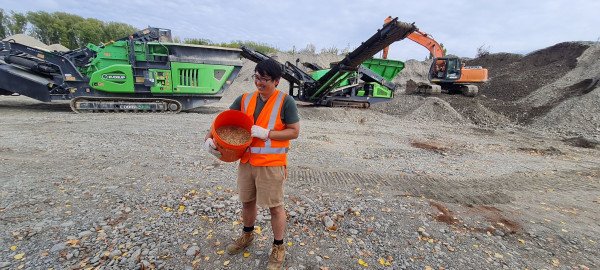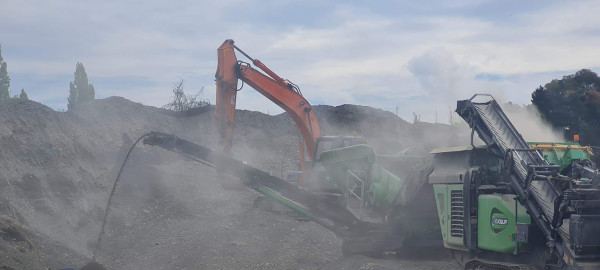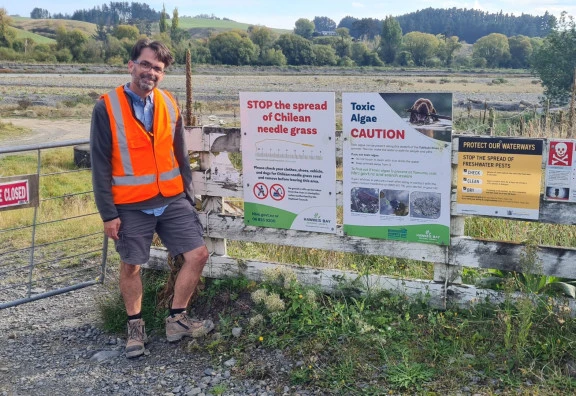Chilean needle grass – regulated by Regional Councils across New Zealand - with its sharp, barbed seeds that can pierce the eyes and skin of livestock, is a persistent and painful biosecurity challenge. It spreads mainly via human activity and animals, but concerns are growing about whether gravel extraction from riverbeds may be making the problem worse — moving seeds of many different weed species from infested sites to clean ones.
To get ahead of the issue, AgResearch scientists recently teamed up with contractors operating in Hawke’s Bay and Mid Canterbury, who are known for supplying high-quality gravel for roads and civil construction. Funded by a collective of regional councils, the research team, led by Dr Chris Buddenhagen, tested how well commercial gravel processing machinery can stop different weed seeds in their tracks.
“We’re working with contractors equipped with the latest gear — large-scale screening and crushing equipment used every day in gravel processing,” explains Chris. “The machinery is impressive, and the collaboration with contractors has been fantastic.”
Science meets steel
The research is focused on two main techniques: sieving (which separates gravel by size) and crushing (which pulverises larger stones). To test their effectiveness, AgResearch scientists spiked gravel loads with known quantities of crop seeds that served as proxies for a variety of weed species, including Chilean needle grass, lupin, yellow bristle grass and nassella tussock. The gravel was then run through standard commercial processing.

Zachary Ngow gets ready to insert seeds into the gravel to be processed (behind him).
The results?
Crushing alone significantly reduced seed numbers, but not entirely. When sieving was added before crushing, effectiveness improved — though this still didn’t eliminate all seeds.
“We’re seeing meaningful reductions, after sieving and crushing stages, but no method is foolproof yet,” Buddenhagen says. “And each site and machine setup likely perform differently so it's a complex puzzle.”
Floods, gravel and weed spread
The issue of gravel contamination with regulated weed seeds gained particular urgency after Cyclone Gabrielle, when widespread flooding mobilised large volumes of gravel — and potentially weed seed — through river systems in Hawke’s Bay. One contractor site sits near a hillside visibly infested with Chilean needle grass. The risk of seeds spreading during gravel transport, or even post-flood remediation, is real.

Heavy machinery processes the gravel with seeds loaded into it so the AgResearch team can complete their testing.
Gravel removal is vital for flood protection and infrastructure, but they also have legal obligations to control regulated weeds like Chilean needle grass. With millions of cubic metres of riverbed gravel slated for removal to prevent future flooding, the stakes are high.
“The intersection of flood control, infrastructure, and biosecurity makes this a thorny issue,” Buddenhagen says. “But science is offering real-world insights into the possible solutions.”
Evolving methods, meaningful impact
Initially, researchers planned to track seed emergence by spreading processed gravel in field plots, but the cost was prohibitive. Instead, they adopted a more controlled lab-based approach: add seeds, process the gravel, and then test what survived.
“It’s not just about whether seeds survive — it’s about how many, and how machinery can change that,” says Buddenhagen.
While no one’s expecting to find a silver bullet, Councils are hoping this research will help guide the development of best-practice guidelines with gravel contractors. There’s interest in further refining methods, like double sieving, additional crushing passes, or post-processing monitoring.
And there’s a commercial incentive too. Gravel contractors rely on access to local riverbeds and biosecurity concerns can jeopardise those concessions.
“Some contractors will be taking a proactive approach,” says Buddenhagen. “Just like going organic in farming, they could voluntarily adopt standards to reduce weed seeds. That kind of leadership could protect their business and help slow the spread of a damaging pest.”
AgResearch’s work on Chilean needle grass is just one example of its global reputation in biosecurity science — a field where practical, hands-on experimentation and strong industry partnerships are essential.
“This is science in steel-toed boots,” Buddenhagen says. “It’s research that rolls up its sleeves and gets stuck in with industry to solve real problems.”
